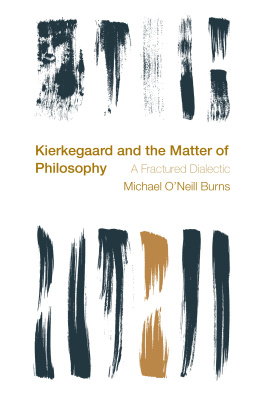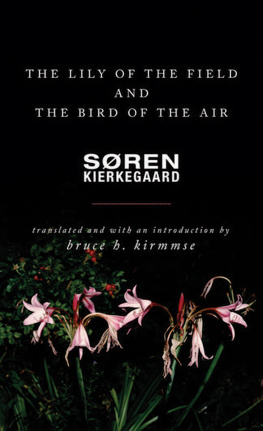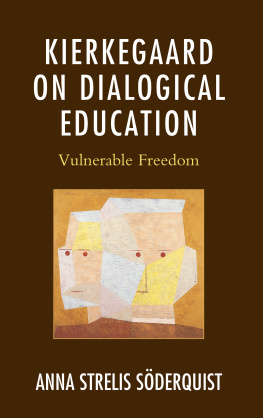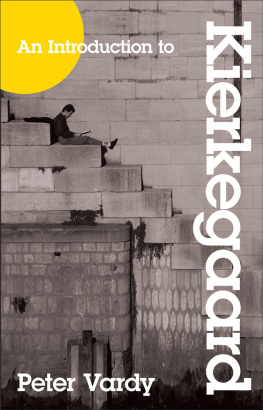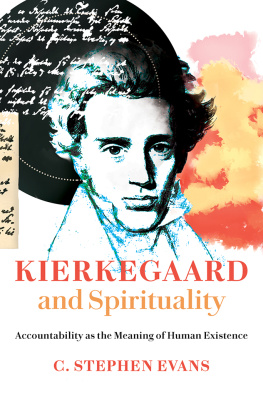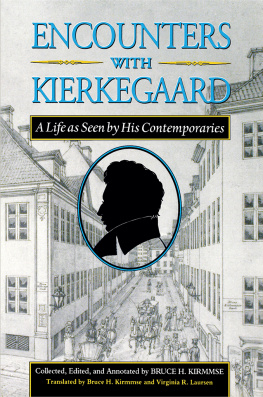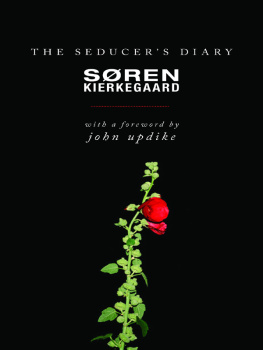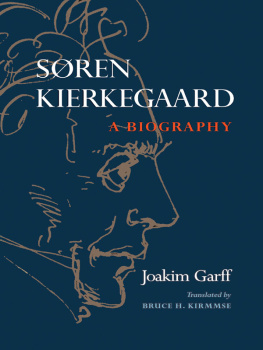THE CORSAIR AFFAIR
KIERKEGAARDS WRITINGS, XIII

KIERKEGAARD
THE CORSAIR AFFAIR
AND ARTICLES RELATED TO THE WRITINGS
Edited and Translated
with Introduction and Notes by
Howard V. Hong and
Edna H. Hong

Copyright 1982 by Howard V. Hong
Published by Princeton University Press,
41 William Street, Princeton, New Jersey 08540
In the United Kingdom: Princeton University Press, 6 Oxford Street,
Woodstock, Oxfordshire OX20 1TW
All Rights Reserved
Third printing, and first paperback printing, 2009
Paperback ISBN: 978-0-691-14075-9
The Library of Congress has cataloged the cloth edition of this book as follows
Kierkegaard, Sren Aabye, 18131855.
The Corsair affair.
(Kierkegaards writings ; 13)
Bibliography: p.
Includes index.
1. Kierkegaard, Sren Aabye, 18131855Addresses,
essays, lectures. 2. CorsarenAddresses, essays,
lectures. 3. Goldschmidt, Mer Aron, 18191887
Addresses, essays, lectures. 4. Mller, Peder Ludvig,
18141865Addresses, essays, lectures. I. Hong,
Howard Vincent, 1912 . II. Hong, Edna Hatlestad,
1913 . III. Title. IV. Series: Kierkegaard, Sren
Aabye, 18131855. Works. English. 1978 ; 13.
B4376.K48 1981 198.9 80-7538
ISBN 0-691-07246-9
British Library Cataloging-in-Publication Data is available
Printed on acid-free paper.
Designed by Frank Mahood
press.princeton.edu
CONTENTS
HISTORICAL INTRODUCTION
THE CORSAIR AFFAIR
I hope that someone will soon write a fully documented history of the Corsair affair, declared W. H. Auden a decade ago.
The Corsair affair has been called the most renowned controversy in Danish literary history. The immediate occasion was literaryP. L. Mllers review of Kierkegaards Stages on Lifes Way (see Supplement, pp. 96-104)and those involved were writers, but the issues were more ethical, social, and philosophical than literary. Similarly, the consequences of the controversy for the participants were ethical, philosophical, and religious, with appropriate effects upon their writing.
The relation between Goldschmidt, the editor of The Corsair (1840-1846) and the pseudonymous author of the novel En Jde (A Jew; 1845), and Kierkegaard was one of mutual admiration: on the one hand, a young writer who sought the esteem and advice of a more acknowledged writer, who, on the other hand, discerned the talent and possibilities of the younger man. They first met at a party in 1838, and Goldschmidt recounts that Kierkegaards eyes were sagacious, lively, and masterful, with a mixture of good humor
Their second meeting
When Either/Or, edited by Victor Eremita, appeared in 1843, Mller and Goldschmidt were more or less agreed that Victor Eremita was the most brilliant Greek to emerge again on the scene. There was a wealth of thought, wit, irony, mastery, especially the last. He was masterly in everything and could himself be Either/Or, Both/And, if not personally, then in his thought. Goldschmidt even sent Victor Eremita and Mller an invitation to a celebration (with a flask of rare Italian wine), although, of course, the guest of honor could be present only invisibly. the book was praised, albeit in a typically offhanded way.
In 1845, The Corsair lauded the editor of Stages on Lifes Way by suggesting that it would be more enjoyable to eat dry bread and drink water with Hilarius Bookbinder than to
Goldschmidts esteem for Kierkegaard and the pseudonymous works was genuine, as were Kierkegaards admiration of and expectations for Goldschmidt. As reputed editor of The Corsair, Goldschmidt had made himself something of an outsider in a way consistent with the papers flamboyant motto: His hand shall be against all, and the hands of all against him. Whatever Kierkegaard thought about the paper, he thought well of the young writer, and Goldschmidt appreciated the older writers interest and his willingness to converse with him publicly. According to Rikard Magnussen, at that time the position of Jews in Denmark was still such that the oppression of the race could force upon the gifted Jew a constrictive inner insecurity and a passionate need for recognition, a need that in reality still contained a certain contempt for the society whose recognition it sought....
Goldschmidt edited the satirical, oppositionist weekly paper for six years, from 1840 to 1846, a time called The Corsairs reign of terror. Magnussen writes of the tyranny the scandal sheet The Corsair exercised over the citizenry at the time.
Then P. L. Mller loomed up.
Mller had entered the University of Copenhagen in 1832, Kierkegaard in 1830. Mller won the gold medal in 1841 for his essay on French poetry; Kierkegaard submitted and successfully defended his dissertation on irony in the same year. Mller moved from medicine to theology to esthetics; Kierkegaard began in theology, became occupied with esthetics and literature, and wrote a philosophical dissertation. During this prolonged student decade, they must have known each other, although there are no references to Mller in Kierkegaards extant journals and papers from that time. Frithiof Brandt, however, convincingly makes a case for the thesis that P. L. Mller, the Byronic esthete, a modern Don Juan type, was the model for Johannes the Seducer in Volume I of Either/Or (1843).
After winning the gold medal for his essay, Mller nourished the hope that he might become Adam Oehlenschlgers the main part of which was a clever and in some ways discerning, but generally uncomprehending, review of Kierkegaards Stages on Lifes Way, cast in the form of a discussion among the author and various persons at Sor Academy.
Carsten Hauch, in whose house the discussion presented in A Visit in Sor supposedly took place, was involved in Mllers writing of the piece, although Kierkegaard did not know or suspect it. In a letter to Mller, Hauch wrote: The observations I have expressed regarding Kierkegaard I gladly turn over to you for your use, since I am assured that you will use them with discretion; meanwhile, you will thereby bring upon yourself a heavy battle with Denmarks most subtle dialectician.
Georg Brandes later characterized Mllers piece in Ga as a frivolous and dishonorable article: frivolous, because its
Goldschmidt, thinking of Mllers desire to establish himself as critic and esthetician, saw the piece as giving the impression of being a manifesto originating at or supported by Sor Academy.... It was a kind of cunning that perhaps only poets have; they are so simple-minded that in their craftiness they become both ludicrous and pathetic as a result.... Mller created the impression that such gentlemen seemed to lend their authority, and in many respects the whole work was splendid, perhaps the most lively and energetic he had written. But he had caught a Tartar.
The Tartar responded directly with an article in the newspaper Fdrelandet (December 27, 1845)The Activity of a Traveling Esthetician and How He Still Happened to Pay for the Dinner,
Why did Kierkegaard respond to Mllers article in a way that eventually had momentous consequences? The review itself was the occasion, not the central issue. The most accentuated part of the review did indeed invade the personal Regine-Kierkegaard relation, which in
Next page

